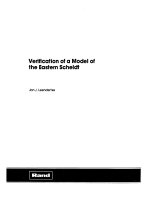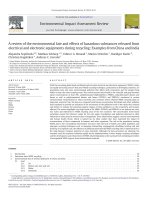Chapter 6- A Tour of the Cell pps
Bạn đang xem bản rút gọn của tài liệu. Xem và tải ngay bản đầy đủ của tài liệu tại đây (7.93 MB, 124 trang )
Copyright © 2008 Pearson Education, Inc., publishing as Pearson Benjamin Cummings
PowerPoint
®
Lecture Presentations for
Biology
Eighth Edition
Neil Campbell and Jane Reece
Lectures by Chris Romero, updated by Erin Barley with contributions from Joan Sharp
Chapter 6
A Tour of the Cell
Overview: The Fundamental Units of Life
•
All organisms are made of cells
•
The cell is the simplest collection of matter
that can live
•
Cell structure is correlated to cellular function
•
All cells are related by their descent(nguon
goc,dong doi, the he) from earlier cells
Copyright © 2008 Pearson Education, Inc., publishing as Pearson Benjamin Cummings
Fig. 6-1
Concept 6.1: To study cells, biologists use
microscopes and the tools of biochemistry
•
Though usually too small to be seen by the
unaided eye, cells can be complex
Copyright © 2008 Pearson Education, Inc., publishing as Pearson Benjamin Cummings
Microscopy
•
Scientists use microscopes to visualize cells
too small to see with the naked eye
•
In a light microscope (LM), visible light
passes through a specimen and then through
glass lenses(co thau kinh), which
magnify(phong dai) the image
Copyright © 2008 Pearson Education, Inc., publishing as Pearson Benjamin Cummings
•
The quality of an image depends on
–
Magnification, the ratio of an object’s image
size to its real size
–
Resolution, the measure of the clarity(trong
sang,ro rang) of the image, or the minimum
distance of two distinguishable points
–
Contrast, visible differences in parts of the
sample
Copyright © 2008 Pearson Education, Inc., publishing as Pearson Benjamin Cummings
Fig. 6-2
10 m
1 m
0.1 m
1 cm
1 mm
100 µm
10 µm
1 µm
100 nm
10 nm
1 nm
0.1 nm
Atoms
Small molecules
Lipids
Proteins
Ribosomes
Viruses
Smallest bacteria
Mitochondrion
Nucleus
Most bacteria
Most plant and
animal cells
Frog egg
Chicken egg
Length of some
nerve and
muscle cells
Human height
Unaided eye
Light microscope
Electron microscope
•
LMs can magnify effectively to about 1,000
times the size of the actual specimen
•
Various techniques enhance(giam,ha xuong)
contrast and enable cell components(thanh
phan) to be stained or labeled
•
Most subcellular structures, including
organelles(co quan) (membrane(mang)-
enclosed compartments(ngăn)), are too small
to be resolved by an LM
Copyright © 2008 Pearson Education, Inc., publishing as Pearson Benjamin Cummings
Fig. 6-3
TECHNIQUE RESULTS
(a) Brightfield (unstained
specimen)
(b) Brightfield (stained
specimen)
50 µm
(c) Phase-contrast
(d) Differential-interference-
contrast (Nomarski)
(e) Fluorescence
(f) Confocal
50 µm
50 µm
Fig. 6-3ab
(a) Brightfield (unstained(ko có vết nhơ)
specimen)
(b) Brightfield (stained
specimen)
TECHNIQUE RESULTS
50 µm
Fig. 6-3cd
(c) Phase-contrast
(d) Differential-interference-
contrast (Nomarski)
TECHNIQUE
RESULTS
Fig. 6-3e
(e) Fluorescence(su phat huynh quang)
TECHNIQUE
RESULTS
50 µm
Fig. 6-3f
(f) Confocal(cung tieu diem)
TECHNIQUE
RESULTS
50 µm
•
Two basic types of electron microscopes
(EMs) are used to study subcellular structures
•
Scanning electron microscopes (SEMs)
focus a beam(chum, tia) of electrons onto the
surface of a specimen(mau vat), providing
images that look 3-D
•
Transmission electron microscopes (TEMs)
focus a beam of electrons through a specimen
•
TEMs are used mainly to study the internal
structure of cells
Copyright © 2008 Pearson Education, Inc., publishing as Pearson Benjamin Cummings
Fig. 6-4
(a) Scanning electron
microscopy (SEM)
TECHNIQUE RESULTS
(b) Transmission electron
microscopy (TEM)
Cilia
Longitudinal
section of
cilium
Cross section
of cilium
1 µm
1 µm
Cell Fractionation(phan cat te bao)
•
Cell fractionation takes cells apart and
separates the major organelles from one
another
•
Ultracentrifuges(may sieu ly tam) fractionate
cells into their component parts
•
Cell fractionation enables scientists to
determine(xac dinh) the functions of organelles
•
Biochemistry(khoa hoa sinh) and cytology(te
bao hoc) help correlate(tuong quan) cell
function with structure
Copyright © 2008 Pearson Education, Inc., publishing as Pearson Benjamin Cummings
Fig. 6-5
Homogenization
TECHNIQUE
Homogenate
Tissue
cells
1,000 g
(1,000 times the
force of gravity)
10 min
Differential centrifugation
Supernatant poured
into next tube
20,000 g
20 min
80,000 g
60 min
Pellet rich in
nuclei and
cellular debris
Pellet rich in
mitochondria
(and chloro-
plasts if cells
are from a plant)
Pellet rich in
“microsomes”
(pieces of plasma
membranes and
cells’ internal
membranes)
150,000 g
3 hr
Pellet rich in
ribosomes
Fig. 6-5a
Homogenization
Homogenate
Differential centrifugation
Tissue
cells
TECHNIQUE
Fig. 6-5b
1,000 g
(1,000 times the
force of gravity)
10 min
Supernatant poured
into next tube
20,000 g
20 min
80,000 g
60 min
150,000 g
3 hr
Pellet rich in
nuclei and
cellular debris
Pellet rich in
mitochondria
(and chloro-
plasts if cells
are from a plant)
Pellet rich in
“microsomes”
(pieces of plasma
membranes and
cells’ internal
membranes)
Pellet rich in
ribosomes
TECHNIQUE (cont.)
Concept 6.2: Eukaryotic cells have internal
membranes that compartmentalize their functions
•
The basic structural and functional unit of every
organism is one of two types of cells:
prokaryotic(nhan so) or eukaryotic(nhan thuc)
•
Only organisms of the domains(pham vi,linh
vuc) Bacteria and Archaea consist of
prokaryotic cells
•
Protists(sinh vat don bao), fungi(nam), animals,
and plants all consist of eukaryotic cells
Copyright © 2008 Pearson Education, Inc., publishing as Pearson Benjamin Cummings
Comparing Prokaryotic and Eukaryotic Cells
•
Basic features of all cells:
–
Plasma membrane
–
Semifluid(sền sêt) substance called cytosol
–
Chromosomes (carry genes)
–
Ribosomes (make proteins)
Copyright © 2008 Pearson Education, Inc., publishing as Pearson Benjamin Cummings
•
Prokaryotic cells(te bao nhan so) are
characterized by having
–
No nucleus
–
DNA in an unbound region called the nucleoid
–
No membrane-bound organelles
–
Cytoplasm(te bao chat) bound by the plasma
membrane(mang te bao)
Copyright © 2008 Pearson Education, Inc., publishing as Pearson Benjamin Cummings
Fig. 6-6
Fimbriae
Nucleoid
Ribosomes
Plasma membrane
Cell
wall(vach
te bao)
Capsule(ba
o,vo)
Flagella(roi
)
Bacterial
chromosome
(a) A typical
rod-shaped
bacterium
(b) A thin section
through the
bacterium
Bacillus
coagulans (TEM)
0.5 µm
•
Eukaryotic cells(te bao nhan thuc) are
characterized by having
–
DNA in a nucleus that is bounded by a
membranous nuclear envelope(mang, bao)
–
Membrane-bound organelles
–
Cytoplasm(tebao chat) in the region between
the plasma membrane and nucleus
•
Eukaryotic cells are generally much larger than
prokaryotic cells
Copyright © 2008 Pearson Education, Inc., publishing as Pearson Benjamin Cummings
•
The plasma membrane is a selective
barrier(hang rao) that allows sufficient(đủ)
passage(su di qua,chuyen qua) of oxygen,
nutrients, and waste to service the volume of
every cell
•
The general structure of a biological membrane
is a double layer(mang kep) of phospholipids
Copyright © 2008 Pearson Education, Inc., publishing as Pearson Benjamin Cummings









